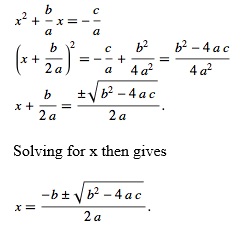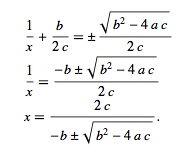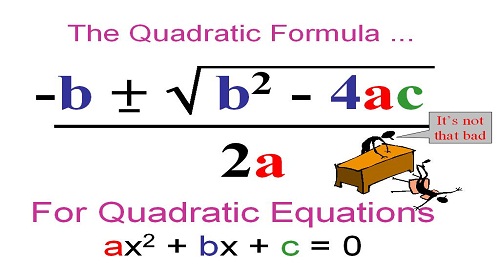Quadratic Equation Assignment Help
Quadratic Equation Introduction
A quadratic equation is a second-order polynomial equation in a single variable x
ax2 + bx + c = 0,

With a ≠. Because it is a second-order polynomial equation, the fundamental theorem of algebra guarantees that it has two solutions. These solutions may be both real, or both complex.
Quadratic formula and its derivation:
The roots ‘x’ can be found by completing the square,

This equation is known as the quadratic formula.
An alternate form of the quadratic equation is given by dividing (◇) through by x2:
a + b/x + c/x2 = 0
c(1/x2 + b/cx) + a = 0
c(1/x + b/2c)2 = c(b/2c)2 - a = b2/4c - 4ac/4c = b2 - 4ac/4c
Therefore,

Now consider the equation expressed in the form
a2 x2 + a1 x + a0 = 0,
With solutions and. These solutions satisfy Vieta's formulas
z1 + z2 = - a1/a2
z1z2 = a0/a2

Coefficients of Quadratic equation:
A quadratic equation with real coefficients can have either one or two distinct real roots, or two distinct complex roots. In this case the discriminant determines the number and nature of the roots. There are three cases:
If the discriminant is positive, then there are two distinct roots
-b + √∆/2a and -b - √∆/2a,
If the discriminant is zero, then there is exactly one real root
-b/2a, Sometimes called a repeated or double root.
If the discriminant is negative, then there are two distinct (non-real) complex roots and no real roots.
-b/2a + i√-∆/2a and -b/2a - i√-∆/2a,
The properties of the symmetric polynomials appearing in Vieta's formulas then give
z21 + z22 = a21 - 2a0 a2/a22
z31 + z32 = - a31 - 3a0a1a2/a32
z41 + z42 = a41 - 4a0 a21 a2 + 2a20 a22 / a42


